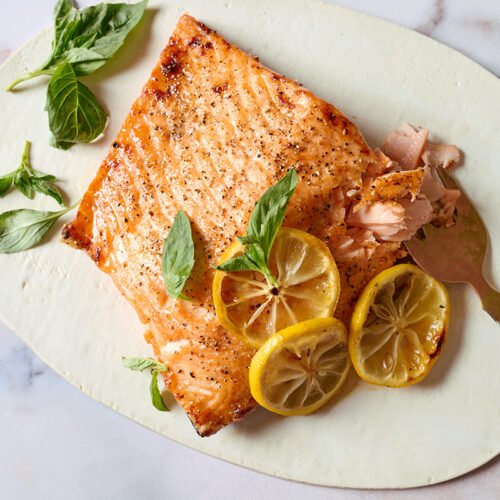
The Salmon Fillet with Manuka Honey MGO 100 Glaze and Citrus Salad is a culinary masterpiece that brings together a harmonious blend of flavors and textures. The dish features a rich and buttery salmon fillet, perfectly glazed with Manuka honey MGO 100, known for its sweet and aromatic qualities. The glaze not only enhances the natural flavors of the salmon but also adds a delightful layer of complexity, making each bite a gourmet experience.
Accompanying the salmon is a vibrant citrus salad that serves as the perfect counterbalance. The refreshing and tangy notes of the citrus fruits cut through the richness of the salmon, creating a well-rounded and satisfying meal. The combination of these elements makes this dish not only delicious but also visually appealing, with the bright colors of the citrus salad complementing the golden glaze of the salmon.
This blog will delve into the specifics of preparing this exquisite dish, from selecting high-quality ingredients to mastering the cooking techniques that bring out the best flavors. Additionally, we will explore the health benefits of the key ingredients, such as the omega-3 fatty acids in salmon, which are known for their heart-health benefits, and the unique properties of Manuka honey MGO 100, renowned for its antibacterial and anti-inflammatory effects.
Whether you are a seasoned home cook or a culinary enthusiast looking to impress your guests, this recipe provides a delightful challenge that promises to elevate your dining experience. Stay tuned as we guide you through the steps to create this gourmet delight in your own kitchen.
To prepare the exquisite Salmon Fillet with Manuka Honey MGO 100 Glaze and Citrus Salad, you will need the following ingredients:
For the Salmon Fillet:
For the Citrus Salad:
Optional Ingredients:
These carefully chosen ingredients, particularly the Manuka honey MGO 100, bring a unique sweetness and a rich, complex flavor to the dish, perfectly complementing the fresh citrus elements. The addition of fresh herbs like mint and parsley adds a refreshing touch, while the optional ingredients allow for personal customization, ensuring a gourmet dining experience with every bite.
Manuka honey, particularly with an MGO 100 rating, stands out due to its remarkable health benefits, making it an exceptional choice for culinary and medicinal purposes. MGO, or methylglyoxal, is a naturally occurring compound found in Manuka honey, responsible for its potent antibacterial properties. Honey with an MGO 100 rating has been verified to contain a high concentration of this compound, which significantly enhances its ability to combat harmful bacteria and promote overall health.
A key advantage of Manuka honey is its ability to bolster the immune system. Its antibacterial properties help in inhibiting the growth of bacteria, thus reducing the risk of infections. Additionally, the antioxidant content in Manuka honey aids in neutralizing free radicals, which are unstable molecules that can cause oxidative stress and damage cells. By reducing oxidative stress, Manuka honey supports overall cellular health and can contribute to a stronger immune response.
Another notable benefit of Manuka honey is its positive impact on digestive health. The antibacterial properties help maintain a healthy balance of gut bacteria, which is crucial for effective digestion and nutrient absorption. Moreover, Manuka honey has been found to have prebiotic effects, promoting the growth of beneficial gut bacteria that aid in digestion and help prevent gastrointestinal issues.
Beyond its health benefits, Manuka honey MGO 100 is a superior choice for glazing salmon fillets due to its unique flavor profile and consistency. Its natural sweetness and slight earthiness complement the savory richness of salmon, creating a harmonious blend of flavors. The high MGO content also ensures that the honey retains its beneficial properties even when used in cooking, providing both culinary delight and health advantages.
Incorporating Manuka honey MGO 100 into your diet, whether through gourmet recipes like a salmon fillet glaze or as a daily supplement, can offer substantial health benefits. Its unparalleled antibacterial and antioxidant properties make it a valuable addition to any health-conscious individual’s regimen.
Choosing the right salmon fillet is crucial in creating a gourmet dish that impresses both visually and in taste. When selecting your fillet, focus on three primary indicators of freshness: color, smell, and texture. A high-quality salmon fillet should exhibit a vibrant, rich color, ranging from pink to deep red, depending on the variety. Avoid fillets with any discoloration or dullness, as these are signs of aging or poor quality.
The smell is another critical factor. Fresh salmon should have a clean, oceanic scent, free of any strong or fishy odors. If you detect any unpleasant smell, it’s best to choose another piece. Texture plays an equally important role; the flesh should be firm and resilient to the touch, bouncing back when pressed gently. A mushy or overly soft texture suggests that the salmon is past its prime.
Once you’ve secured a top-quality fillet, proper preparation is essential to maximize its flavor and texture. Start by rinsing the salmon under cold water to remove any surface impurities. After rinsing, use paper towels to pat the fillet dry, ensuring it is free of excess moisture. This step is key to achieving a beautifully crisp exterior during cooking.
Inspect the fillet for any remaining pin bones by running your fingers over the flesh. If you find any, use a pair of fish tweezers or needle-nose pliers to carefully remove them. Deboning enhances the dining experience, making the fillet easier and more pleasant to eat.
Finally, consider trimming any thin edges of the fillet that may cook faster than the rest, ensuring even cooking throughout. With these steps, you prepare the salmon fillet to absorb the flavors of the Manuka Honey MGO 100 glaze and complement the refreshing citrus salad, resulting in a dish that is both delectable and visually stunning.
Creating the Manuka honey glaze is an essential step in preparing the salmon fillet with Manuka Honey MGO 100 glaze and citrus salad. This glaze not only enhances the flavor but also adds a delightful sheen to the dish. To start, gather the following ingredients: Manuka Honey MGO 100, soy sauce, lemon juice, and minced garlic.
Begin by measuring out a quarter cup of Manuka Honey MGO 100 and placing it in a small saucepan. Manuka honey is renowned for its unique properties and distinct flavor, which will be the star of this glaze. Add two tablespoons of soy sauce to the saucepan, balancing the sweetness of the honey with a touch of savory umami.
Next, squeeze the juice of one fresh lemon into the mixture, approximately two tablespoons. The acidity of the lemon juice will cut through the sweetness and add a fresh citrus note. Incorporate one clove of minced garlic to infuse the glaze with a subtle aromatic depth. Stir the ingredients together until well combined.
Place the saucepan over medium heat, stirring continuously. It is crucial to maintain a moderate temperature to avoid burning the honey. As the mixture heats, the honey will begin to thin, allowing the flavors to meld together. Continue stirring until the glaze reaches a smooth, pourable consistency, which should take around five to seven minutes.
Once the glaze has achieved the desired consistency, remove it from the heat and let it cool slightly. The glaze should be thick enough to coat the back of a spoon but still fluid enough to drizzle over the salmon fillet. This Manuka honey glaze, with its perfect balance of sweet, savory, and tangy notes, will elevate the salmon to a gourmet level, making it a memorable centerpiece for any meal.
Cooking the perfect salmon fillet with a Manuka honey glaze requires attention to detail and the right techniques. The first step is to choose your preferred cooking method: baking, grilling, or pan-searing. Each method brings out different flavors and textures, so consider what best suits your culinary preference.
If you opt for baking, preheat your oven to 375°F (190°C). Place the salmon fillet on a parchment-lined baking sheet, skin-side down. To achieve an even cook, apply a light layer of olive oil and season with salt and pepper. Bake for 12-15 minutes, or until the salmon flakes easily with a fork. For the Manuka honey glaze, combine Manuka honey MGO 100, a splash of soy sauce, and a squeeze of fresh lemon juice. Brush this mixture onto the salmon in the last five minutes of baking to allow the glaze to caramelize without burning.
Grilling is another excellent option for cooking salmon fillet. Preheat your grill to medium-high heat and lightly oil the grates to prevent sticking. Place the fillet skin-side down, grilling for 4-5 minutes per side. The key is to resist flipping the fillet too early; let it cook undisturbed to form a beautiful crust. During the last few minutes, brush on the Manuka honey glaze. The high heat will create a lovely charred effect, enhancing the salmon’s natural sweetness.
For pan-searing, heat a non-stick skillet over medium-high heat and add a small amount of oil. Place the fillet skin-side down and cook for about 4 minutes. Gently flip the salmon and cook for an additional 3 minutes. In the final minute, reduce the heat to low and brush the Manuka honey glaze onto the fillet. This method ensures a crispy exterior while keeping the inside moist and flavorful.
Regardless of the method, the key to perfect doneness is to cook the salmon until it reaches an internal temperature of 145°F (63°C). This ensures the fish is cooked through while retaining its moisture. Properly applying the Manuka honey glaze during the cooking process not only enhances the flavor but also adds a glossy finish that makes the dish visually appealing.
Crafting a delightful citrus salad is essential in complementing the rich flavors of the salmon fillet with Manuka honey MGO 100 glaze. Begin by selecting a variety of fresh citrus fruits, such as oranges, grapefruits, and lemons. These fruits not only add vibrant colors to the dish but also bring a refreshing contrast to the savory salmon.
To segment the citrus fruits, start by cutting off the top and bottom of each fruit, creating flat surfaces. Stand the fruit on one of these flat ends and carefully slice away the peel and pith, following the natural curve of the fruit. Once peeled, hold the fruit over a bowl to catch any juices and use a sharp knife to cut between the membranes, releasing the citrus segments. This method, known as supreming, ensures each segment is free of any bitter pith and enhances the salad’s overall texture.
Next, prepare the dressing to drizzle over the citrus segments. In a small bowl, whisk together extra virgin olive oil, a tablespoon of Manuka honey MGO 100, and a splash of fresh lemon juice. The olive oil offers a smooth base, while the Manuka honey adds a subtle sweetness that ties in beautifully with the glazed salmon. Fresh herbs, such as mint or basil, can be finely chopped and added to the dressing for an aromatic touch. Season with a pinch of salt and freshly ground black pepper to taste.
Combine the citrus segments in a salad bowl, gently tossing them with the prepared dressing to ensure even coating. The result is a harmonious blend of flavors and textures, where the sweetness of the honey, the tanginess of the citrus, and the herbaceous notes create a balanced and refreshing accompaniment to the salmon fillet. This citrus salad not only enhances the visual appeal of the meal but also provides a zesty counterpoint to the rich, honey-glazed salmon, making each bite a gourmet delight.
Creating a visually appealing presentation for your salmon fillet with Manuka Honey MGO 100 glaze and citrus salad not only enhances the dining experience but also showcases your culinary skills. Begin by placing the glazed salmon fillet at the center or slightly off-center of a large, white plate. This not only highlights the vibrant colors but also provides a clean canvas for the rest of your dish.
Next, arrange the citrus salad around the salmon, allowing the bright oranges, reds, and greens to contrast beautifully with the rich, caramelized hue of the salmon. For an added touch of elegance, consider layering the citrus slices in a fan pattern or a decorative spiral. Fresh herbs like dill, parsley, or basil can be sprinkled around the salad for a burst of color and freshness. Alternatively, edible flowers such as nasturtiums or pansies can be used to add a sophisticated and exotic flair.
As for garnishing, a light drizzle of extra Manuka Honey MGO 100 glaze over the salmon and around the plate can amplify the dish’s visual and flavor appeal. Thin slices of radish or finely chopped chives can be scattered over the salad for additional texture and vibrancy. To create a restaurant-quality presentation, ensure each element is thoughtfully placed, and the plate is free from smudges or excess sauce.
When it comes to serving, pairing this gourmet dish with a light, crisp white wine such as Sauvignon Blanc or Pinot Grigio can elevate the overall dining experience. For a non-alcoholic option, consider a refreshing beverage like sparkling water infused with a splash of citrus juice or a light herbal tea. These choices complement the flavors of the dish without overpowering them, ensuring a balanced and delightful meal.
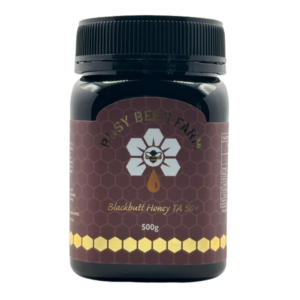
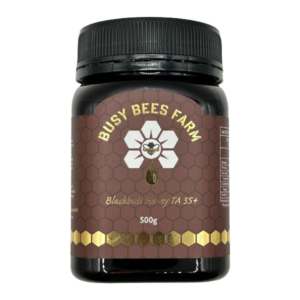



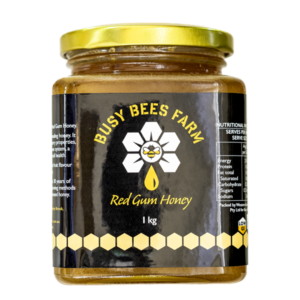

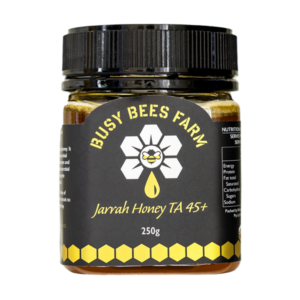

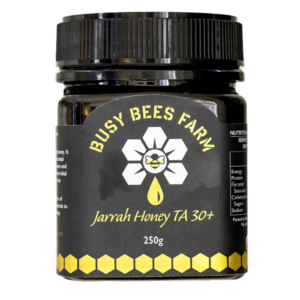
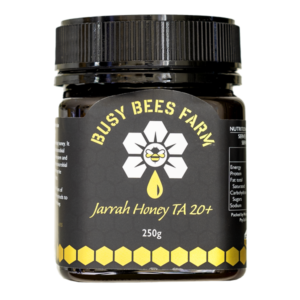

Copyright© 2024 Busy Bees Farm / Australia